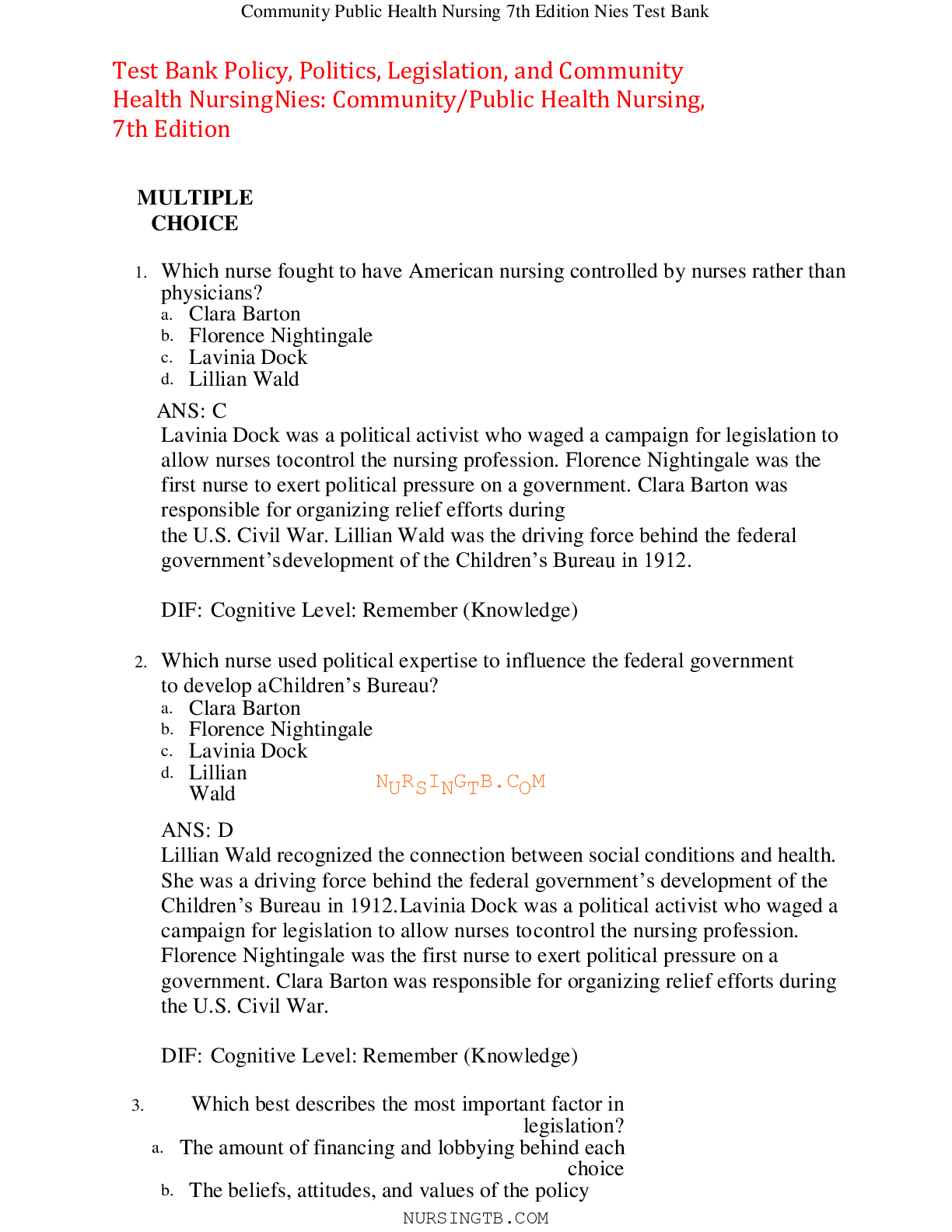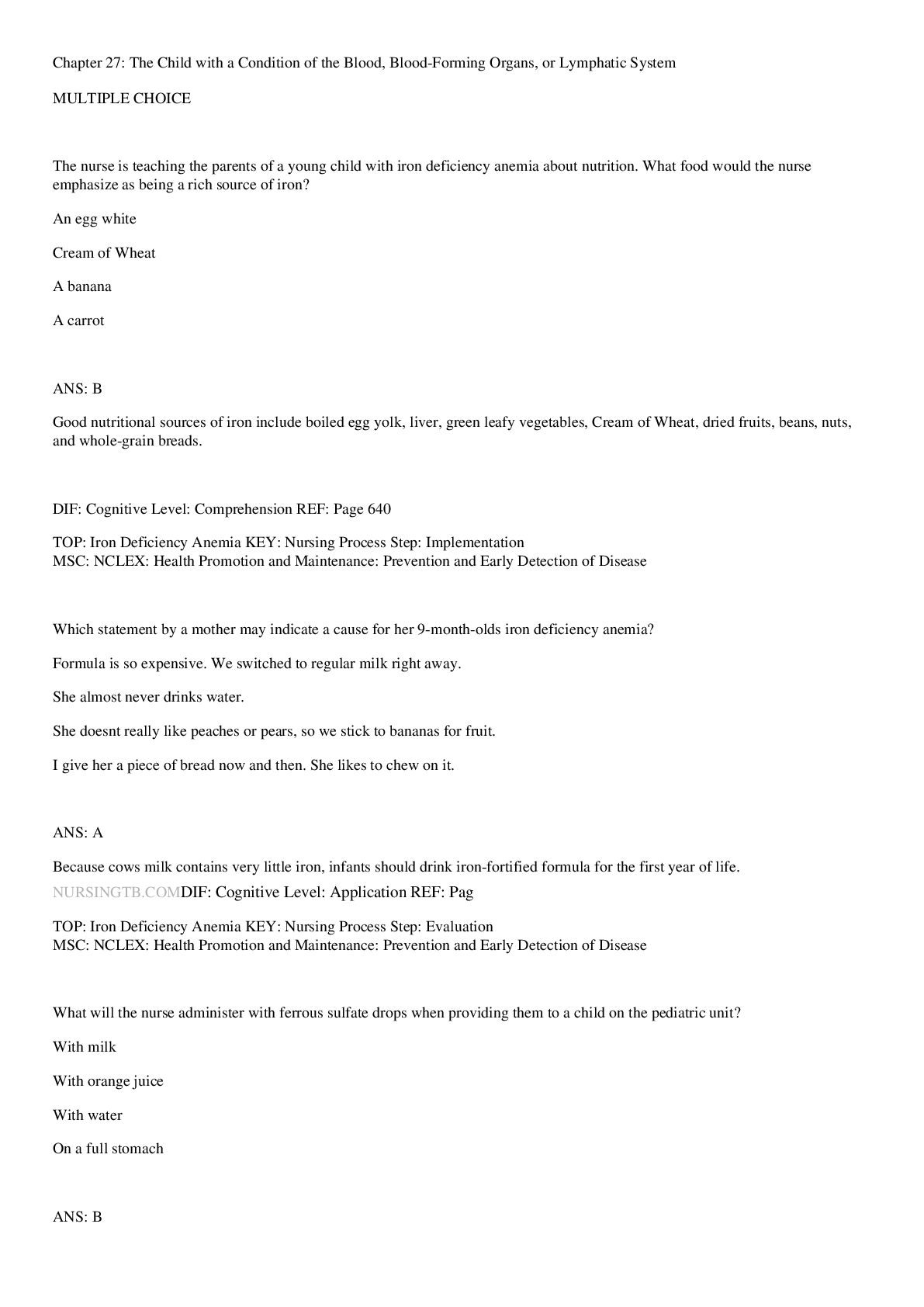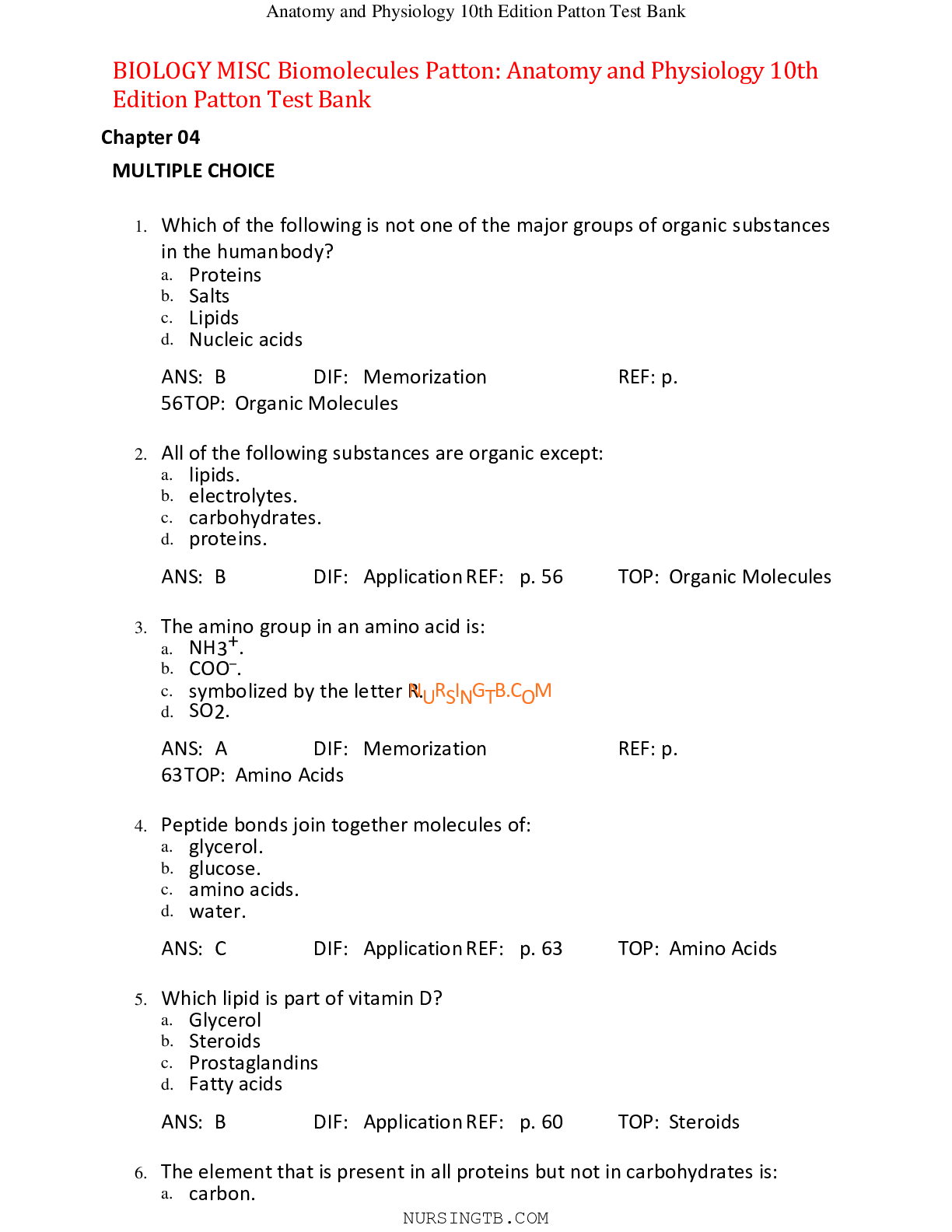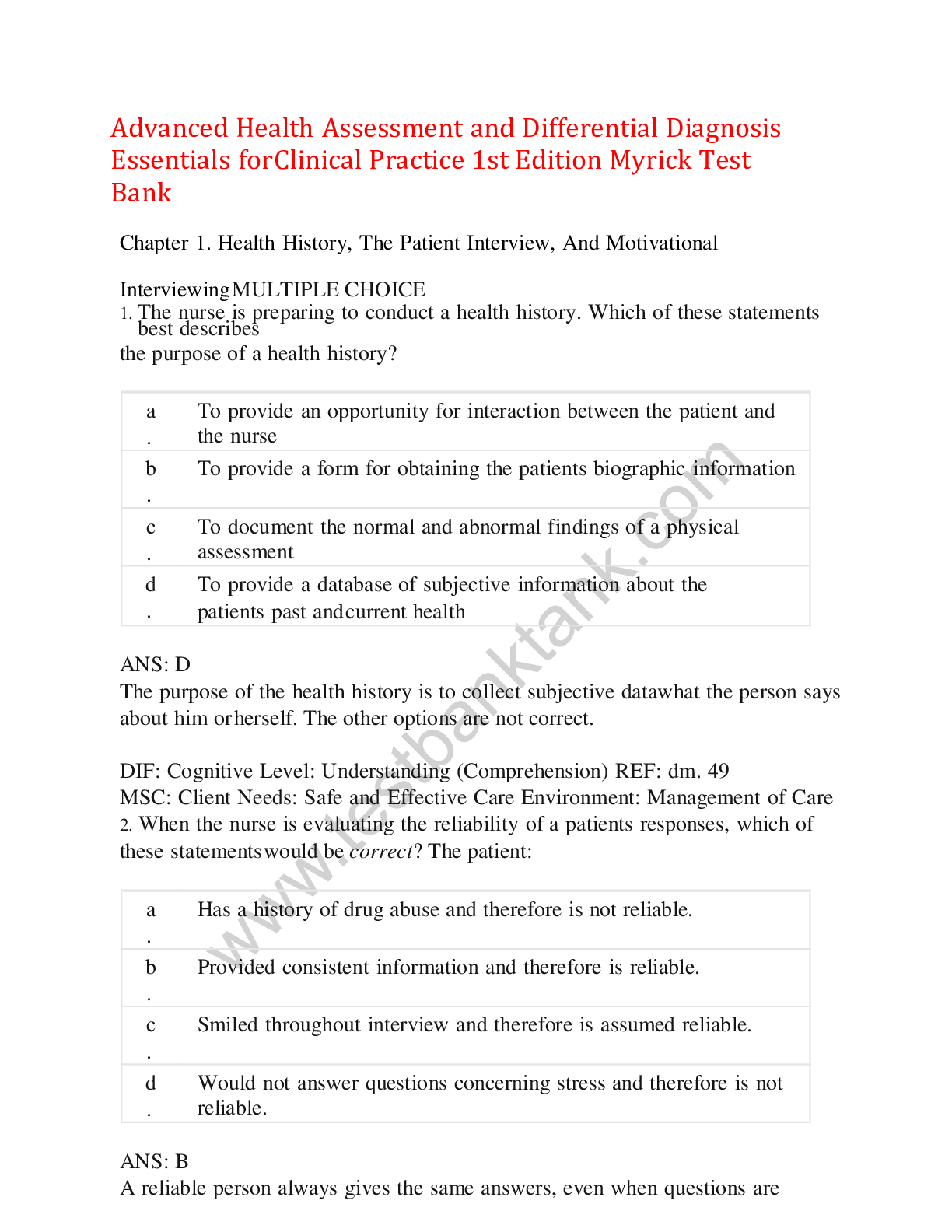*NURSING > TEST BANK > Test Bank: Working With the Family Keltner: Psychiatric Nursing, 8th Edition,100% CORRECT (All)
Test Bank: Working With the Family Keltner: Psychiatric Nursing, 8th Edition,100% CORRECT
Document Content and Description Below
Test Bank: Working With the Family Keltner: Psychiatric Nursing, 8th Edition MULTIPLE CHOICE 1. When a nurse assesses a family, which family task has the highest priority to facilitate healthy... family functioning? a. Allocation of family resources b. Physical maintenance and safety c. Maintenance of order and authority d. Reproduction of new family members ANS: B Physical and safety needs are given greater importance in Maslow hierarchy of needs than other needs since it addresses the basic safety needs. DIF: Cognitive level: Analyzing TOP: Nursing process: Assessment MSC: Client Needs: Health Promotion and Maintenance 2. Which documentation of family assessment indicates a healthy and functional family? a. Members provide mutual support. b. Power is distributed equally among all members. c. Members believe that there are specific causes for events. d. Under stress, members turn inward and become enmeshed. ANS: A Healthy families nurture andNsupRportItheGir mBe.mCbersM, buffer against stress, and provide stability and cohesion. The distracters are unrelated to healthy family function or suggest incorrect dynamics. DIF: Cognitive level: Understanding TOP: Nursing process: Assessment MSC: Client Needs: Health Promotion and Maintenance 3. A 15-year-old patient is hospitalized after a suicide attempt. The adolescent lives with his mother, stepfather, and several siblings. When performing a family assessment, the nurse must first focus on securing what information? a. How the family expresses and manages emotion. b. The names and relationships of the patient’s family members. c. The communication patterns between the patient and parents. d. The meaning the patient’s suicide attempt has for family members. ANS: B The names and relationships of the patient’s family members constitute the most fundamental information and should be obtained first. Without this, the nurse cannot fully process the other responses. DIF: Cognitive level: Analyzing TOP: Nursing process: Assessment MSC: Client Needs: Health Promotion and Maintenance 4. Which information is the nurse most likely to find when assessing the family of a patient with a serious and persistent mental illness? a. The family exhibits many characteristics of dysfunctional families. b. Several family members have serious problems with their physical health. c. Power in the family is maintained in the parental dyad and rarely delegated. d. The stress of living with a mentally ill individual has negatively affected family function. ANS: D The information almost universally obtained is that the family is under stress associated with having a mentally ill member. This stress lowers the family’s level of functioning in at least one significant way. Stress does not necessarily mean the family has become dysfunctional. DIF: Cognitive level: Understanding TOP: Nursing process: Assessment MSC: Client Needs: Psychosocial Integrity 5. The patient’s parent asks the nurse, “Why do you want to do a family assessment? My child is the patient, not the rest of us.” What response best addresses the parent’s concern? a. “Family dysfunction might have caused the mental illness.” b. “Family members provide more accurate information than the patient.” c. “Family assessment is part of the protocol for care of all patients with mental illness.” d. “Every family member’s perception of events is different and adds to the total picture.” ANS: D This response helps the family understand that the opinions of each will be valued. It allows the nurse to assess individual coping and prepares the family for the experience of working together to set goals and solve problems. The other responses are either incorrect or evasive. N R I G B.C M DIF: Cognitive level: Applying TOP: Nursing process: Implementation MSC: Client Needs: Psychosocial Integrity 6. An adult recently diagnosed with a mental illness is hospitalized with pneumonia. The patient and family are very anxious. What outcome should the nurse add to the plan of care for this family to meet their immediate needs? a. Identify and describe effective coping methods. b. Describe the stages of the anticipatory grieving process. c. Recognize the ways dysfunctional communication is expressed in the family. d. Examine previously unexpressed feelings related to the patient’s sexuality. ANS: A Desired outcomes might be set for the family as a whole or for individuals within the family. The outcome most closely associated with the anxiety that each is experiencing is to focus on identifying and describing ways of coping with the anxiety. The other options are not appropriate at this time. DIF: Cognitive level: Applying TOP: Nursing process: Planning MSC: Client Needs: Psychosocial Integrity 7. A parent is admitted to a chemical dependency treatment unit, where the patient’s spouse and adolescent children participate in a family session. What is the most important aspect of family function to be initially assessed? a. Spouse’s co-dependent behaviors b. Interactions among family members c. Patient’s reaction to the family’s anger d. Children’s responses to the family sessions ANS: B Interactions among all family members are the raw material for family problem-solving. By observing interactions, the nurse can help the family make its own assessments of strengths and deficits. The other options are too narrow in scope when compared with the correct option. DIF: Cognitive level: Analyzing TOP: Nursing process: Assessment MSC: Client Needs: Psychosocial Integrity 8. A parent is admitted to a chemical dependency treatment unit. The patient’s spouse and adolescent children attend a family session. What is the priority assessment question to ask family members to best assess family unit characteristics? a. “What changes are most important to you?” b. “How are feelings expressed in your family?” c. “What types of family education would benefit your family?” d. “Can you identify a long-term goal for improved functioning?” ANS: B It is important to understand family characteristics in both the family of origin and the present family. The other questions are related more to outcome identification and planning intervention, neither of which should be attempted until assessment is complete. DIF: Cognitive level: Analyzing TOP: Nursing process: Assessment MSC: Client Needs: PsychosocNiaUl IRntSegIriNtyGTB.COM 9. A nurse interviews a homeless parent with two teenage children. To best assess the family’s use of resources, what question should the nurse ask? a. “Can you describe a problem your family has successfully resolved?” b. “What community agencies have you found helpful in the past?” c. “Do you feel you have adequate resources to survive?” d. “What is one thing you dislike about this family?” ANS: B The correct option asks about resource use in an open, direct fashion. It will give information about choices that the family has made to use other family members or resources in the community. The other questions do not address prior use of resources. DIF: Cognitive level: Applying TOP: Nursing process: Assessment MSC: Client Needs: Psychosocial Integrity 10. Two divorced people plan to marry. The man has a teenager, and the woman has a toddler. This family will benefit most from what form of counseling? a. Guidance about parenting at two developmental levels. b. Role-playing opportunities for conflict resolution. c. Formal teaching about problem-solving skills. d. Referral to a family therapist with divorce counseling experience. ANS: A The newly formed family will be coping with tasks associated with the stages of rearing preschool children and dealing with teenagers. These stages require different knowledge and skills. There is no evidence of a problem, so the distracters are not indicated. DIF: Cognitive level: Applying TOP: Nursing process: Planning MSC: Client Needs: Health Promotion and Maintenance 11. Parents of a teenager recently diagnosed with serious mental illness express dismay. One parent says, “Our hopes for our child’s future are ruined. We probably won’t ever have grandchildren.” The nurse should use interventions to assist with the parent’s demonstration of what process? a. Denial b. Mourning c. Acting out d. Manipulation ANS: B Grief or mourning is a common reaction to having a family member diagnosed with mental illness. The grief stems from actual or potential losses such as ability to function, altered family functioning, income, and altered future prospects. Data do not support choosing any of the other options. DIF: Cognitive level: Understanding TOP: Nursing process: Implementation MSC: Client Needs: Psychosocial Integrity 12. Parents of a teenager recently diagnosed with serious mental illness express dismay. One parent says, “Our child sometimes acts so strangely that we don’t invite friends to the house. Sometimes we don’t get any NslUeeRp.SWIeNqGuTit Bta.kiCngOvMacations.” Which nursing diagnosis applies? a. Impaired parenting b. Dysfunctional grieving c. Impaired social interaction d. Interrupted family processes ANS: D Interrupted family processes are evident in the face of disruptions in family functioning as a result of having a mentally ill member. Data support the possibility of this diagnosis. Data are insufficient to consider the other diagnoses. DIF: Cognitive level: Understanding TOP: Nursing process: Assessment MSC: Client Needs: Health Promotion and Maintenance 13. A family expresses helplessness related to dealing with a mentally ill member’s odd behaviors, mood swings, and argumentativeness. Which nursing intervention for the family should be included into the careplan to help reduce interpersonal stress by learning new coping skills? a. Express sympathy regularly. b. Involve local social services. c. Explain symptoms of relapse. d. Role-play problem situations. ANS: D Helping a family learn to set limits and deal with difficult behaviors can often be accomplished by using role-playing situations, which give family members the opportunity to try new, more effective approaches. The other options would not provide learning opportunities. DIF: Cognitive level: Applying TOP: Nursing process: Implementation MSC: Client Needs: Health Promotion and Maintenance 14. Parents of a mentally ill teenager say, “We’ve never known anyone who was mentally ill. We have no one to talk to because none of our friends understand the problems.” What intervention by the nurse would be most helpful in meeting the parent’s expressed need? a. Referring the parents to a family support group b. Building their self-esteem as coping parents c. Teaching techniques of therapeutic communication d. Facilitating achievement of normal developmental tasks ANS: A The need for support can be clearly identified. Referrals are made when working with families whose needs are unmet. A support group such as the National Alliance for the Mentally Ill (NAMI) will provide these parents with the support of others who have had similar experiences and with whom they can share feelings and experiences. The distracters are less relevant to their need to interact with others parenting a mentally ill teen. DIF: Cognitive level: Applying TOP: Nursing process: Implementation MSC: Client Needs: Health Promotion and Maintenance 15. What assessment question should the nurse ask to assess a family’s ability to cope? a. “What strengths does youNr UfaRmSilIy NhaGveT?B” .COM b. “Do you think your family copes effectively?” c. “Describe how you successfully handled one family problem.” d. “How do you think the current family problem should be resolved?” ANS: C The correct option is the only statement addressing coping strategies used by the family. The other options seek opinions or are closed-ended. DIF: Cognitive level: Applying TOP: Nursing process: Assessment MSC: Client Needs: Health Promotion and Maintenance 16. Which scenario best illustrates scapegoating within a family? a. Messages of aggression are sent by the identified patient to selected family members. b. Family members project problems of the family onto one particular family member. c. The identified patient threatens separation to induce feelings of isolation and despair. d. Family members give the identified patient nonverbal messages that conflict with verbal messages. ANS: B Scapegoating projects blame for family problems onto a member who is less powerful. The purpose of this projection is to distract from issues or dysfunctional behaviors in the family members. None of the other options deals with blames and power. DIF: Cognitive level: Understanding TOP: Nursing process: Assessment MSC: Client Needs: Health Promotion and Maintenance 17. A patient has become verbally abusive toward their spouse and oldest child since losing a job 6 months ago. The child ran away twice, and the spouse has become depressed. What is the most appropriate nursing diagnosis for this family? a. Impaired parenting, related to verbal abuse of oldest child b. Impaired social interaction, related to disruption of family bonds c. Ineffective individual coping, related to fears about economic stability d. Disabled family coping, related to insecurity secondary to loss of family income ANS: D Disabled family coping refers to the behavior of a significant family member that disables his or her own capacity as well as another’s capacity to perform tasks essential to adaptation. The distracters are inaccurate because more than one individual is affected by the stressors. DIF: Cognitive level: Analyzing TOP: Nursing process: Assessment MSC: Client Needs: Health Promotion and Maintenance 18. A parent says, “My son and I argue constantly since he started using drugs. When I talk to him about not using drugs, he tells me to stay out of his business.” What nursing action most appropriately addresses the parent’s concern? a. Educate the parent about the stages of family development. b. Report the son to law enfNorUceRmSeIntNaGutThoBri.tieCsO. M c. Refer the son for substance abuse treatment. d. Make a referral for family therapy. ANS: D Family therapy is indicated, and the nurse should provide a referral. Reporting the child to law enforcement would undermine trust and violate confidentiality. The other distracters may occur later. DIF: Cognitive level: Applying TOP: Nursing process: Implementation MSC: Client Needs: Health Promotion and Maintenance 19. Which option describes an action that is common among healthy families? a. One parent takes care of the children. The other parent earns income and maintains the home. b. A family has strict boundaries that require members to address problems inside the family. c. A couple requires their adolescent children to attend church services three times a week. d. A couple renews their marital relationship after their children become adults. ANS: D Revamping the marital relationship after children move out of the family of origin indicates that the family is moving through its stages of development. Strict family boundaries or roles interfere with flexibility and the use of outside resources. Adolescents should have some input into deciding their activities. DIF: Cognitive level: Understanding TOP: Nursing process: Assessment MSC: Client Needs: Health Promotion and Maintenance MULTIPLE RESPONSE 1. After a parent is hospitalized with severe depression, family members say, “We’re falling apart. Nobody knows what to expect, who should make decisions, or what to do to keep the family together.” Which interventions should the nurse include in the plan of care for this family? (Select all that apply.) a. Help the family set realistic expectations. b. Provide empathy, acceptance, and support. c. Empower the family by teaching problem-solving. d. Negotiate role flexibility among family members. e. Focus on the family rather than on the patient in planning. ANS: A, B, C, D The correct answers address expressed needs of the family. The other option is inappropriate since the issues relate to the entire family and so much include all family member’s to the degree they are capable of participating. DIF: Cognitive level: Applying TOP: Nursing process: Implementation MSC: Client Needs: PsychosocNiaUl IRntSegIriNtyGTB.COM 2. Which situations are most likely to place severe, disabling stress on a family? (Select all that apply.) a. A parent needs long-term care after sustaining a severe brain injury. b. The youngest child in a family leaves for college in another state. c. A spouse is diagnosed with liver failure and needs a transplant. d. Parents of three children, age 9, 7, and 2 years, get a divorce. e. A parent retires after working at the same job for 28 years. ANS: A, C, D Major illnesses place severe, potentially disabling stress on families. The distracters identify normal milestones in a family’s development. DIF: Cognitive level: Analyzing TOP: Nursing process: Assessment MSC: Client Needs: Health Promotion and Maintenance [Show More]
Last updated: 1 year ago
Preview 1 out of 13 pages
Instant download

Instant download
Reviews( 0 )
Document information
Connected school, study & course
About the document
Uploaded On
Oct 18, 2021
Number of pages
13
Written in
Additional information
This document has been written for:
Uploaded
Oct 18, 2021
Downloads
0
Views
28





























